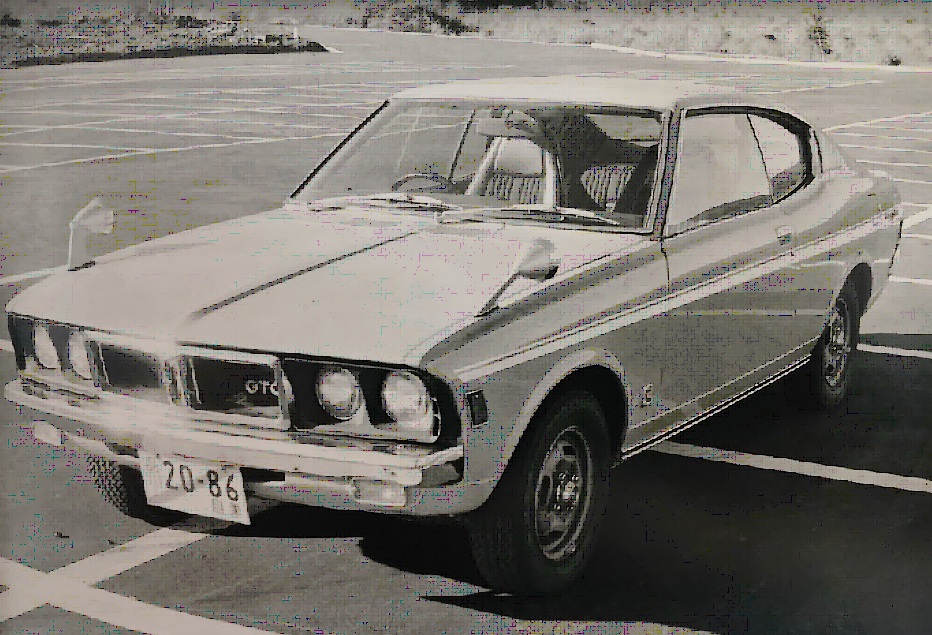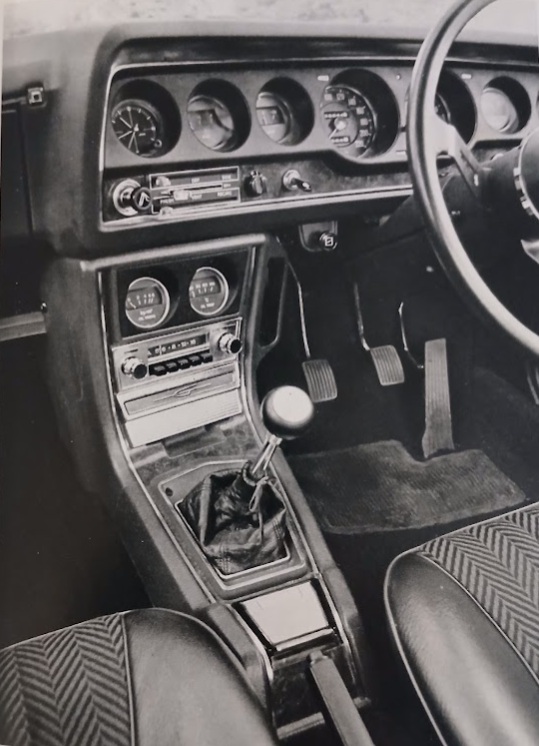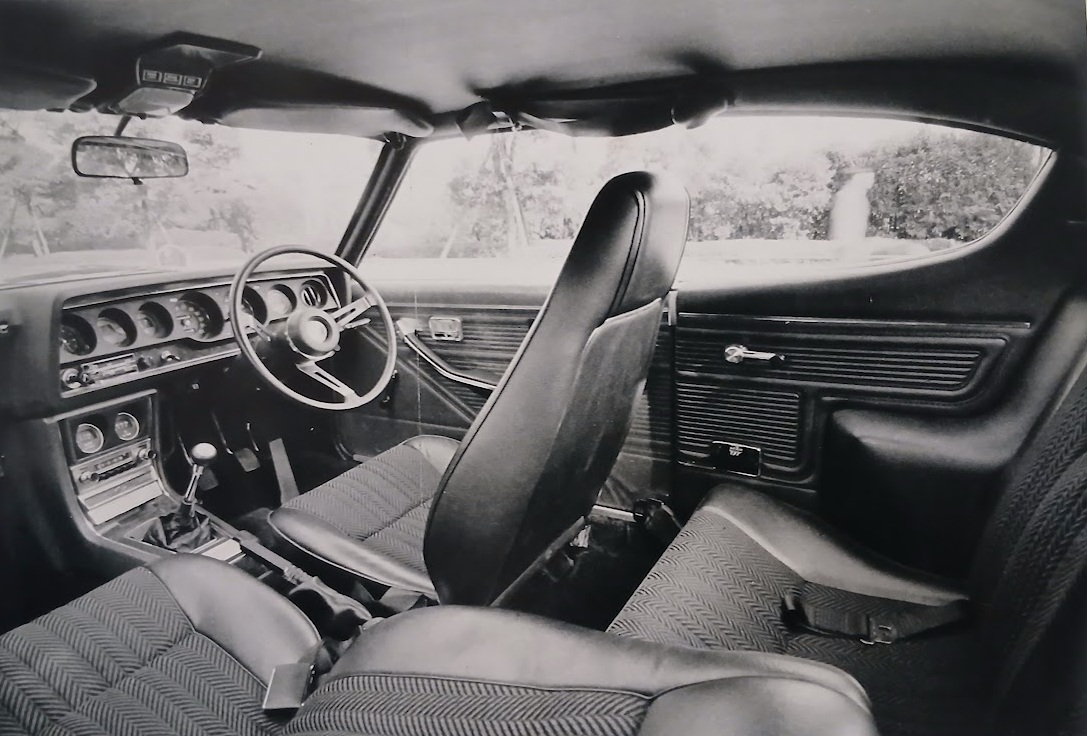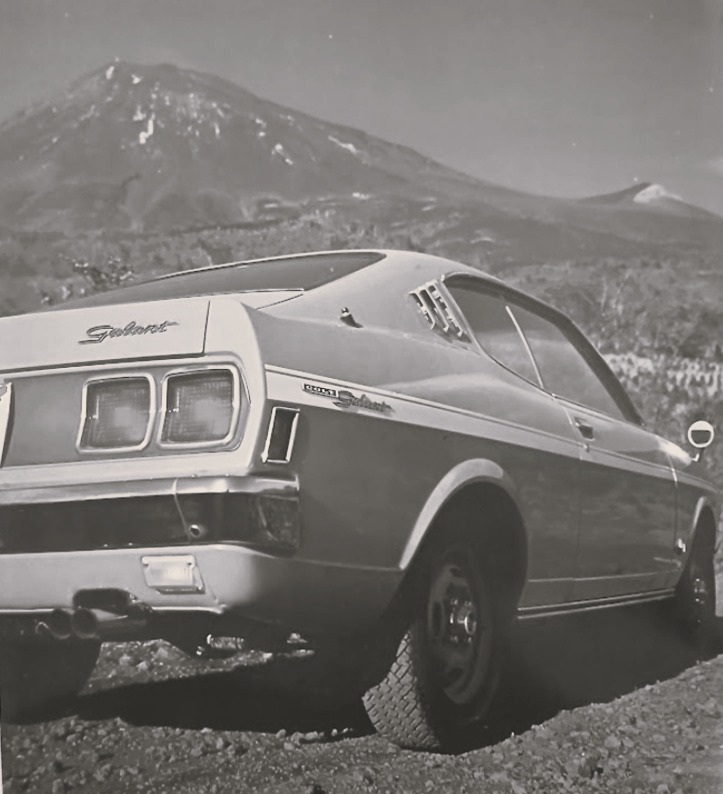Mitsubishi Colt Galant GTO MII (1971)

Publication: Car Graphic
Format: Road Impressions
Date: January 1971
Author: “C/G Test Group” (uncredited)
Road testing the Mitsubishi Galant GTO MII
The Galant GTO series consists of three models: MI, MII, and MR. All three models share the same body, which is cleverly styled like a Ford Mustang shrunk to 1.6-liter size, but each has a different engine. All have a capacity of 1597cc (with a bore increased by 2.4mm over the Galant AI’s 1499cc, but a still-longer stroke at 76.9 x 86mm). However, the MI and MII are SOHC, while the hottest MR has a completely newly designed DOHC head. Output is 100ps/6300rpm for the single-carburetor MI (lower than the Galant AII’s 105ps/67–rpm), 110ps/6700rpm for the twin-SU MII, and 125ps/6800rpm for the DOHC twin-Solex MR. The MI and MII have the same 4-speed gearbox as the AII, but the MR model comes standard with a 5-speed and a torque rod rear suspension. Prices are significantly higher than the Galant Hardtop GS, at 786,000, 843,000, and 1,125,000 yen, respectively.
Based on our experience testing the Galant AII GS sedan and Hardtop (see C/G issues 102 and 109), we had high hopes for the MR, which had 20 more ps and a 5-speed gearbox, and made the arrangements to bring it to Yatabe. Unfortunately, the day before the scheduled test date, we received a call from Mitsubishi’s public relations department informing us that the test car had been in an accident, with their apologies. Mr. Togawa from the motorsports division made great efforts to find a solution, but in the end, we were unable to arrange for an MR by the deadline for the new year’s issue, so we had no choice but to run our tests with the 110ps MII this time.
The biggest selling point of the GTO MII is its mini-Mustang-like design, so let’s start by covering its trendy styling and complete equipment. Because it shares the basic floor pan with the existing Galant A-series, the GTO’s wheelbase and tread width are the same as those of the GS sedan and hardtop, but the body is 45mm longer, 10mm wider, and 25mm lower than the hardtop GS. The overall shape is a typical long-nose, short-deck design, with the nose extended by 100mm compared to the hardtop, while the rear end is cut off in a ducktail style. According to the manufacturer, this ducktail works in the same way as a racing car’s air spoiler, reducing air resistance through a streamlining effect while also generating downforce at the rear, improving stability at high speeds.
The GTO attracted an extraordinary amount of attention wherever it went, likely due to its mini-American-car styling and flashy Kenya Orange paint job. The body cross section, which uses curved glass with a curvature of 50 inches (domestic cars generally have glass that is around 100 inches), gives the GTO a powerful “tension” not found in most Japanese cars, and helps make it look larger than it actually is, regardless of the impact it may have on aerodynamics and livability (more on this later).
The dimensions are essentially the same as the existing hardtop, but the impression from the driver’s seat is very different. The driving position is excellent, with high-back seats with integrated headrests and fabric inserts only in the areas that come into contact with the body, providing a good shape, comfort and feel, and the vinyl leather-wrapped steering wheel includes Mitsubishi’s specialty, a column height adjustment of around 50mm, which allows the driver to tailor its position relative to the gear shift lever and pedals.
The dash, with its nearly ideal layout, wraps around the driver and features a plethora of gauges as densely packed as any high-performance GT we can think of. Two of the seven gauges are located on the center console: oil pressure and oil temperature. Both feature a clean design with white lettering on a black background. However, this is not without its problems. Even if the average user can recognize the information displayed on these gauges, they may not understand what the numbers mean, barring the most technically enthusiastic individuals. For example, the oil temperature indicator could be color-coded to indicate the optimum temperature range (like a tachometer), rather than simply displaying a number, or it could even have a separate warning light. This is the fundamental difference in design between an aircraft flown by professionals and a car driven by amateurs. All gauges have clear plastic lenses, but the fuel and water temperature gauges on our test car were cloudy, making them extremely difficult to read at night.
The safety equipment is also comprehensive. The seat belts are three-point, with an automatic retracting device, and what’s interesting is that there are warning lights for seat belts and door locks on the ceiling behind the rearview mirror. That is, when you start the engine and close the doors, two red lights light up above your head. They turn off if you lock the doors and fasten your seat belt, but if you don’t, they stay lit for 12 to 13 seconds to warn you. If this gets you into the good habit of always wearing your seat belt, then that makes the GTO a safety special edition, and careful attention has also been paid to ensuring visibility to both the front and rear. The wipers are high-speed types with fins, and the windshield washer has four jets. Heated rear windows are not uncommon these days, but the GTO’s has a built-in timer that automatically turns off after 10 minutes of operation. This is a thoughtful touch to prevent forgetting it and wasting battery power.
On the other hand, rear visibility has been sacrificed considerably for the styling. The tail is high, the rear window is shallow, and there are significant blind spots to the rear quarters (i.e. diagonally behind the car), which is a problem, especially when backing up. The driver has no clue as to where the tail ends (fortunately, it is much shorter than you might imagine from inside the car).
The rear seats are spacious for a coupe of this class, and the low seating position provides ample headroom. However, for the same reason, you’re forced to sit cradling your knees, making it unsuitable for long rides. The high front seat backrests mean that forward visibility from the rear seats is extremely poor (a common problem in modern cars), and the steep curve of the windows means that side visibility is also quite limited. Those looking for privacy should try crawling into the GTO’s rear seat.
The first thing we noticed when we got the MII out on the road was that the SOHC engine was unexpectedly noisy. When we picked up the car, we were warned that it might not give representative performance due to incomplete maintenance (it already had a mileage of just under 2,000km), and unfortunately this turned out to be true. The idle fluctuated between 600 and 800rpm, and while it revved up to the redline of 6800rpm, from around 3000rpm there was a sudden increase in unpleasant mechanical noise, and the exhaust system resonance also had a large peak around 4800rpm. Judging from the test car, at least, the GTO MII’s engine is noisier than the AII GS, and its general smoothness was below average. Even at low city speeds, it was extremely noisy in first, second, and third gears, making us want to shift into top gear quickly. We’ve previously praised the AII GS in C/G tests, both the sedan and hardtop, for being extremely smooth and quiet, rivaling even a six-cylinder engine, but the GTO’s engine was a major disappointment.
Aside from noise and general roughness, the GTO’s dynamic performance far surpasses the usual standard of 1.6-liter sports coupes. Since we didn’t conduct instrumented testing this time, we can’t directly compare it to the AII GS sedan we previously tested at Yatabe, but intuitively at least, the GTO has the advantage. Power output is only up by 5ps (4.8%), but torque is up by 6%. Meanwhile, the weight of the car has increased by 50kg, so the horsepower load has increased slightly (from 8.14kg/ps to 8.45kg/ps), but the air resistance has been significantly reduced. The gearbox and final drive are the same as the AII GS, but the tires are 155SR-13 radials, which have a slightly smaller effective radius than the GS’s 6.15-13 bias-plies, so the overall gear ratio is slightly lower, which should improve acceleration.
The last point was confirmed when checking the speedometer error. Previous tests of the AI and AII have shown that the Galant’s speedometer is unusually pessimistic among Japanese cars, which are generally quite lenient. In the case of the AII GS, our on-board test meter showed a true speed of 104km/h when the speedometer read 100km/h, and 167km/h when the speedometer showed 160km/h. In the case of the GTO, its actual speed was 101km/h when the speedometer read 100km/h, probably because the effective diameter of the tire is slightly smaller. However, the odometer was slow and read 2.8% below the actual distance traveled.
According to the near-exactly-accurate speedometer, if you push the engine to the 6800rpm redline in each gear, you will reach speeds of 54, 87, and 132km/h in first, second, and third gear, respectively. If you ignore the aforementioned noise, the engine will easily rev above 7000rpm, and the valve gear tracking is perfect even at 7000+. The 4-speed gearbox shifts smoothly and precisely (though the synchronization isn’t especially powerful), which is a plus, but there is a slightly large gap between third and fourth gear. In top gear, 100km/h is reached around 3600rpm, but downshifting to third for hard acceleration raises the engine speed to 5200rpm, which increases the noise level significantly, making passing maneuvers seem unduly dramatic.
The 185km/h top speed listed in the catalog is almost sure to be achieved, as the speedometer once reached 182km/h on the test course (at about 6500rpm). The GS sedan (with a catalog top speed of 175km/h) tested at Yatabe recorded 173.1km/h (at about 6200rpm). The 1300cc AI sedan (owned by C/G and tested on the same day) surprised us by reaching 147.0km/h, exceeding the catalog’s 145km/h figure. Judging by this, it’s entirely possible that the more powerful and aerodynamic GTO could reach a top speed close to 185km/h. However, this would be the first Japanese car to reliably achieve 185km/h with a 1.6-liter SOHC engine, and even among cars from abroad, the only other car to do so is the BMW 2002ti. On the other hand, this engine is very tenacious even t low speeds, making it very easy to use in the city. It is easy to maintain 30km/h in top gear, and to accelerate smoothly by gradually stepping on the gas from that speed.
The GTO is unique in that it has an oil temperature gauge, so we paid close attention to it during the test; in town it read 80°C, lower than the middle of the range, but after ten minutes on the Tomei Expressway it rose to 90°C, and when we attempted hill climbs at Fuji and Hakone using low gear to the fullest, it momentarily reached 100°C.
The Galant has a reputation for good fuel economy, and this was borne out to some extent in the test of the GTO. On the test day, we drove at our usual fairly fast pace along the Tomei, Hakone, Fuji and Chuo Expressways in convoy with another test car, the Skyline 2000GT-R, achieving an average of 8.35km/l over the 324km measured section (the GT-R returned 6.5km/l). Our CO² test was not accurate as the engine’s idle fluctuated between 600 and 800rpm, but the pointer on the test equipment fluttered around 4%, so we’d say it passed by the skin of its teeth.
The MII’s suspension is basically the same as the AII GS’s, but one leaf has been added to the rear suspension’s semi-elliptic springs, bringing the total to three per side, and it is generally stiffer. The standard tires are 155SR-13 radials, and the test car was fitted with Yokohama GT Special Hi-Blocks. When we drove on the Tomei Expressway, the wind was so strong that windsocks were being blown sideways, so it was the perfect opportunity to test the effects of crosswinds. In short, the GTO is not as strong against crosswinds as the manufacturer claims, and we have to say that it gave the impression of being average or even below average. Up to 100km/h stability was passable, but at 120km/h it was necessary to make constant small steering corrections to keep it going straight, and above that it was necessary to really concentrate on the steering. When observing other cars, they were indeed being blown about quite a bit, but the Skyline 2000GT-R we were also driving had good straight-line stability, as expected, and was hardly affected by the wind.
The MII’s handling is by no means bad, but it cannot be said to be particularly outstanding. One good point is that the steering response is exceptionally good for a Japanese car. Except at parking speeds, the steering effort is very light and quite precise. At normal speeds, the understeer is within a reasonable range, there is little roll, and the car follows steering inputs smoothly. However, cornering at the limit is largely spoiled by the performance of the tires. First of all, for a radial tire, the absolute grip is low and they squeal easily. We thought the AII GS had a good balance between the front and rear suspension, but in the GTO, the rear is stiffer, so the front is relatively weaker, resulting in excessive understeer. In other words, the front wheels break away early, the tires roll onto their sidewalls, and the car loses its balance. We ran the car at the recommended high-speed tire pressures of 1.7/2.0kg/cm², but even with these, the front end’s cornering power felt too low. Part of the blame is undoubtedly due to the narrow 4J rims; for radial tires to be effective, a minimum of 4.5J is necessary. The low lateral stiffness of radial tires is counterproductive otherwise, and the AII GS’s bias-ply tires (Bridgestone Skyway H 6.15-13s) are actually easier to handle.
The servo-equipped disc/drum brakes are one of the GTO’s best features. They are light to the touch and work reliably, with minimal nose dive, making them safe for high-speed driving. The handbrake’s position and effectiveness are also just right. The MII’s ride is considerably stiffer than the previously tested AII GS, with strong up-and-down kicks especially in the rear seats. The suspension is clearly designed for high speeds, and the roughness of the ride is especially noticeable at low speeds, but becomes less pronounced as speed increases. On the other hand, you don’t feel like you’re riding on radial tires over anything other than rough roads, and road noise in general is well muted.
Returning to the interior, we realized once again that the seat design is excellent. The backrest wraps well around the torso, the cushion supports the thighs well, and the three-point seat belt provides almost complete support for the body even against strong lateral forces. The inside door handle also serves as an armrest, making it ideal for resting your elbows when driving leisurely on the highway. The three-speed heater blower is exceptionally quiet, and cool or warm air can be brought in from the side vents on both ends of the dash even when the car is stopped. However, the light switch on the dash and the heater controls are difficult to reach with the seat belt fastened, and it’s a shame that with such a comprehensively equipped interior, there’s no tray for coins. Non-smokers will not hesitate to use the ideally positioned ashtray behind the gearshift lever for this purpose. The interior finish is extremely good, and would surely even be considered “unnecessarily high quality” in the American market.
We’re looking forward to testing the GTO MR with DOHC, 125ps, and the 5-speed gearbox, which is scheduled for next month.
Postscript: Story Photos






